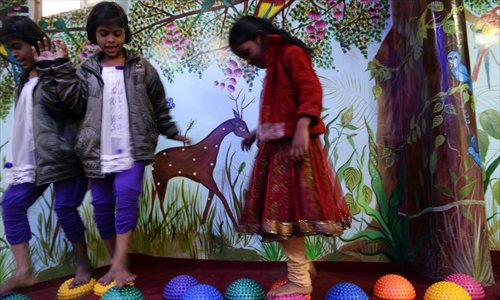HOME >> WORLD
Bhopal gas tragedy lives on
By Shuriah Niazi in Bhopal Source:Global Times Published: 2014-12-1 23:23:02
Government ambivalence, disease plague residents 30 years after

Indian second-generation victims of the Bhopal gas disaster, who are deaf and dumb, play at the Chingari Trust, which was set up to help victims of the disaster. Photo: AFP
"I'll never forget that fateful night, which changed my life forever. I still suffer from breathlessness and other problems. I don't think life will ever be the same for me," said Imrana Bi, a resident of JP Nagar colony, which is close to the now defunct Union Carbide factory that had spewed tons of deadly gas three decades back.Imrana lost her mother that night and her father also died after remaining ill for years.
On the night of December 2, 1984, 40 tons of methyl-isocyanate (MIC) leaked from a pesticide plant in Bhopal in central India killing more than 3,500 people instantly and maiming thousands of others for life.
Thirty years later, people are still battling the legacy of what is often dubbed as the biggest industrial disaster in the world.
Imrana is not alone. In localities such as JP Nagar, Arif Nagar and Atal Ayub Nagar, which are located near the abandoned Carbide plant, every second house has a story to tell about that night which changed the life of thousands of people in the city.
Jagdish Singh, the 29-year-old son of Balram Singh Ahirwar, who also resides in JP Nagar, resembles a 10-year-old child.
His body's growth has stunted. He was still in his mother's womb at the time of the deadly gas leak but inhaled the gas while inside the womb.
Since birth, Jagdish has been suffering from asthma, diabetes and other diseases. He is given insulin shots every morning and evening.
His family's financial situation has likewise prevented him from attending school.
However, his family has not given up hope for his recovery.
His mother, Leela Bai Ahirwar, said, "The gas tragedy has taken away our happiness. When we brought our child to the doctors, they told us it was because I had been exposed to toxic MIC gas. We learned that a large number of children born to gas survivors suffer from a range of diseases and birth defects."
Balram Singh and Leela Bai each received only Rupees 25,000 ($420) as compensation from the government. The money was used to pay for medical bills.
"I believe those who died that night were the lucky ones because those who survived are either crippled or sick. Life has become a burden for them," Saghira Bi, one of the survivors of the Bhopal gas tragedy, told Global Times.
Saghira lost several members of her family. She said that their condition has not improved much 30 years after the tragedy. Activists say even today children born to gas-affected people suffer from ailments such as cerebral palsy, speech and hearing impairment, autism, behavioral problems, epilepsy, heart diseases and others.
Tip of the iceberg
Thousands of tons of hazardous waste lying inside the factory continue to pollute the densely-populated localities surrounding the abandoned plant. In 2012, India's Supreme Court had asked the state government to clean-up 350 metric tons (MT) of toxic waste.
But while the focus has been on the disposal of the toxic waste safely stored inside the factory, the authorities are not even discussing what they plan to do with another 27,000 metric tons of hazardous waste and contaminated soil that, according to government records, lie buried in the solar evaporation ponds 400 meters north of the factory. Besides this, thousands of tons of hazardous waste are buried in 21 unlined pits located inside the factory.
Even efforts to dispose of the 350 MT of waste stored inside the factory have repeatedly failed. Earlier plans to dispose of this waste at a disposal facility in Pithampur near Indore (about 195 kilometers from Bhopal) met with stiff resistance forcing the government to abandon the plan. It remains unclear how the government plans to dispose of the waste.
The Pollution Control Board governing the city of Bhopal has been looking for a suitable facility to dispose of the waste left behind after the 1984 disaster.
Meanwhile, potable water remains a problem for more than 40,000 people living in colonies around the deserted plant. It is feared that a leak from a solar evaporation pond near the factory in particular has been contaminating the groundwater in the area. Toxic waste from the plant had been dumped in this pond for years while the plant was functioning.
The state government dismisses fears that the pond's waste is contaminating the groundwater. But water samples from the pond show that Bhopal's groundwater is indeed contaminated. The government has yet to take any concrete measures to stop the contamination of water and ensure the supply of safe drinking water in the area.
"We have been drinking contaminated water for many years as we have no other option. We know that the water is not fit for consumption. My daughter has been diagnosed with cancer," said Raziya Bi, a resident of nearby Bluemoon colony.
Activists say they have been insisting that groundwater in the colonies is contaminated and unsafe for human consumption but the government isn't concerned.
Local residents rely on hand-pump water for their daily needs. And that, too, remains a problem: the pungent water from hand-pumps also affects their health.
Many of them complain of persistent abdominal pain, headache, coughing and joint pains. Residents say their children are often ill.
Despite the government's lukewarm response, of both the city and state, to calls to clean up the Union Carbide site, NGOs working among the gas victims have continued their fight for justice in both India and the US.
They have succeeded to some extent at least in Indian courts.
Posted in: Asia-Pacific